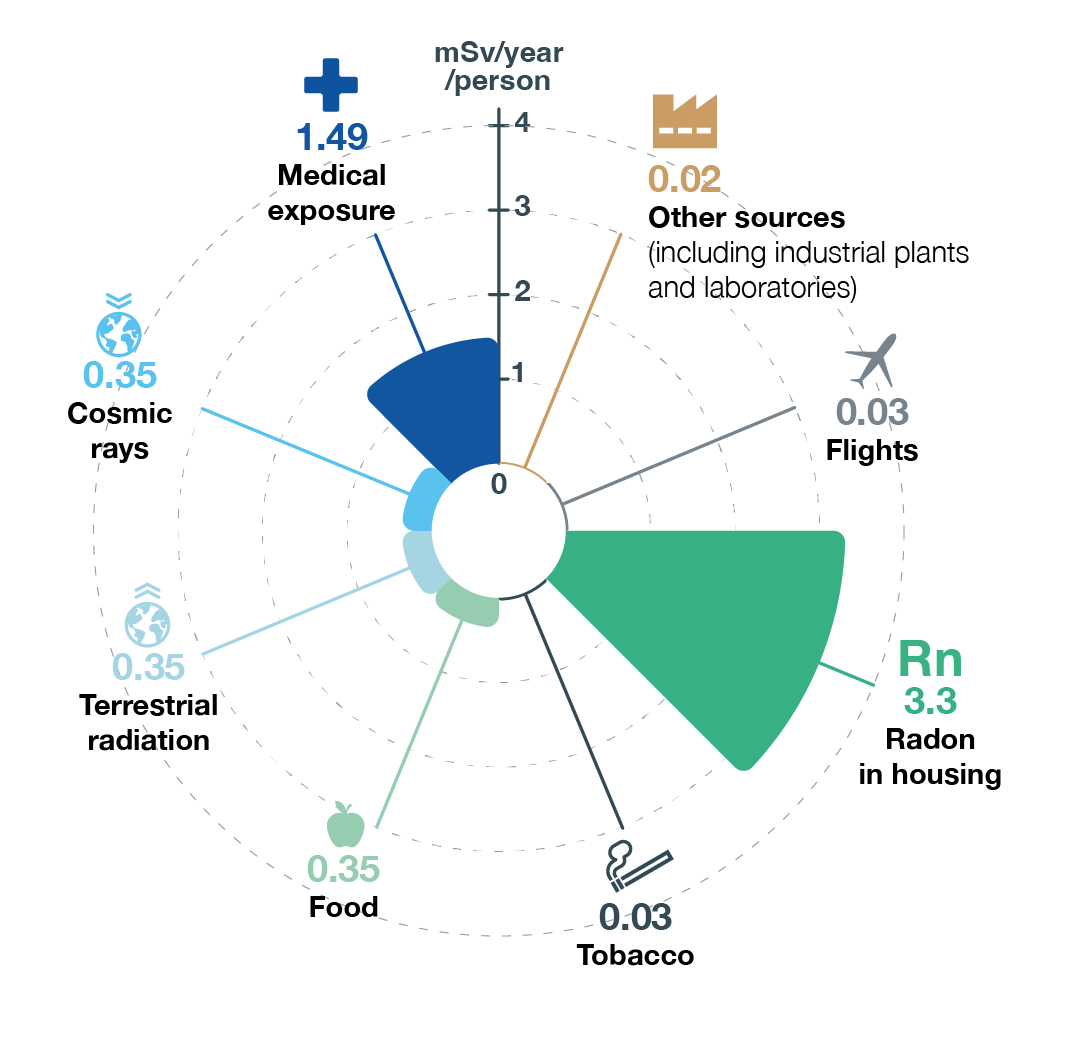Ionising radiation
CERN Environment Report 2021-2022
At CERN, ionising radiation is produced by the collisions of particle beams with matter. CERN’s unique facilities use innovative approaches to minimising the exposure of workers, the public and the environment, making CERN one of the recognised leaders in this field.

LIMITING EXPOSURE
In Europe, the annual dose limit for public exposure from artificial sources, with the exception of exposure for medical reasons, is 1 millisievert (mSv). CERN is committed to keeping its contribution to no more than 0.3 mSv. The actual dose received by any member of the public living near the Laboratory was less than 0.01 mSv in 2022, which is more than 100 times lower than the average annual dose received from medical exposure per person in Switzerland.
At CERN, while the majority of radiation workers are subject to a regulatory limit of 6 mSv/year, a limit of 3 mSv/year is applied in practice. Over the reporting period, no radiation worker at CERN was exposed to more than 1.3 mSv, and 91% of the workers registered a null dose (0 mSv). As a reference, the mean annual exposure to natural and artificial sources in Switzerland is 6 mSv per person per year.
RESPONSIBLE REPORTING
CERN adheres and contributes to internationally recognised radiation protection and safety systems. Following the precautionary principle, the Organization continuously optimises its facilities and practices to minimise its radiological impact. A tripartite agreement signed with the Host States in 2010 ensures transparency and alignment with best practice in radiation protection and safety. As part of this agreement, CERN reports quarterly on its radiological monitoring of the local environment to the Swiss and French authorities. The Organization always strives to apply the latest developments in applicable standards and to adaptto changes in Host State legislation.
State-of-the-art monitoring
Ionising radiation is constantly monitored inside and outside the CERN perimeter. The Laboratory operates an extensive network of environmental radiation monitors and online sampling systems. In 2022, the environmental monitoring programme included 130 measuring stations comprising 640 monitoring channels, 494 of which are dedicated to radiological monitoring.
This robust radiation monitoring infrastructure is underpinned by the Radiation and Environment Monitoring Unified Supervision (REMUS) tool. This innovative system developed by CERN provides supervision, control and data acquisition for the entire suite of monitoring stations and is continually upgraded to ensure that it evolves with the Organization’s needs.
The methods used to evaluate the doses that members of the public could potentially receive are based on widely recognised models and standards and consider the specific nature of CERN’s facilities. A revision of the models was completed in 2022 and was agreed with the Host States authorities. The revised models will be used from now on for all future assessments of CERN’s radiological environmental impact.
CERN collaborates with the Host States to allow their own services to monitor stray radiation and environmental radioactivity inside and outside the CERN perimeter. A network of thermoluminescent dosimeters for assessing ionising radiation around the sites is completed by a high-volume aerosol sampler for sensitive laboratory analyses. A monitoring device on CERN's Meyrin site sends real-time data to the Swiss Federal Office of Public Health (FOPH). In addition, the FOPH conducts annual site measuring campaigns.
In focus
Heinz Vincke is the deputy leader of the CERN Radiation Protection group.
— With accelerators moving towards higher intensity over time, what are the main implications for radiation protection?
HV: Higher intensity would inevitably lead to more radiation. To mitigate this, we have a formalised approach to optimising the design of entire installations and to work coordination, work procedures and the handling of tools.
— What approaches and tools are used for optimal radiation protection management?
HV: During the design stage, we must choose the right materials, shielding and location to minimise the amount of radiation. We mainly use computer-based simulations to ensure optimised dose reduction for personnel and the environment. Furthermore, we use the ActiWiz software, which was developed by the CERN Radiation Protection group. It applies a customised risk assessment model to allow us to choose materials with low activation risks. CERN has developed additional tools that allow us to respect most stringent regulations, such as OPEDOSI for monitoring operational doses received by personnel working in radiation areas, TREC for recording and tracing radioactive material and RAISIN, a database covering all radiation areas at CERN.
The Intervention Management Planning and Activity Coordination Tool (IMPACT) facilitates the assessment of risk, including radiation risk, and ensures a formalised approval process for work in radiation areas. The radiation monitoring tools REMUS (Radiation and Environment Monitoring Unified Supervision) and ERGO (Environment and Radiation Graphic Observer), the visualisation counterpart of REMUS, are further examples of the comprehensive suite of tools in place.
— What about repairing equipment?
HV: The repair of equipment brings specific challenges, especially when we need to work in high-activation areas. For some installations, we can handle equipment or do repairs remotely using robots. When this is not possible, we optimise the work procedure and tools, for example by using mock-up models, so that the time spent in the area of concern is kept to the minimum.
Thanks to this comprehensive approach, CERN has succeeded in continuously reducing the doses to which its personnel and the environment are exposed over the last decade.
Learn more
Questions regarding this report may be addressed to environment.report@cern.ch.
